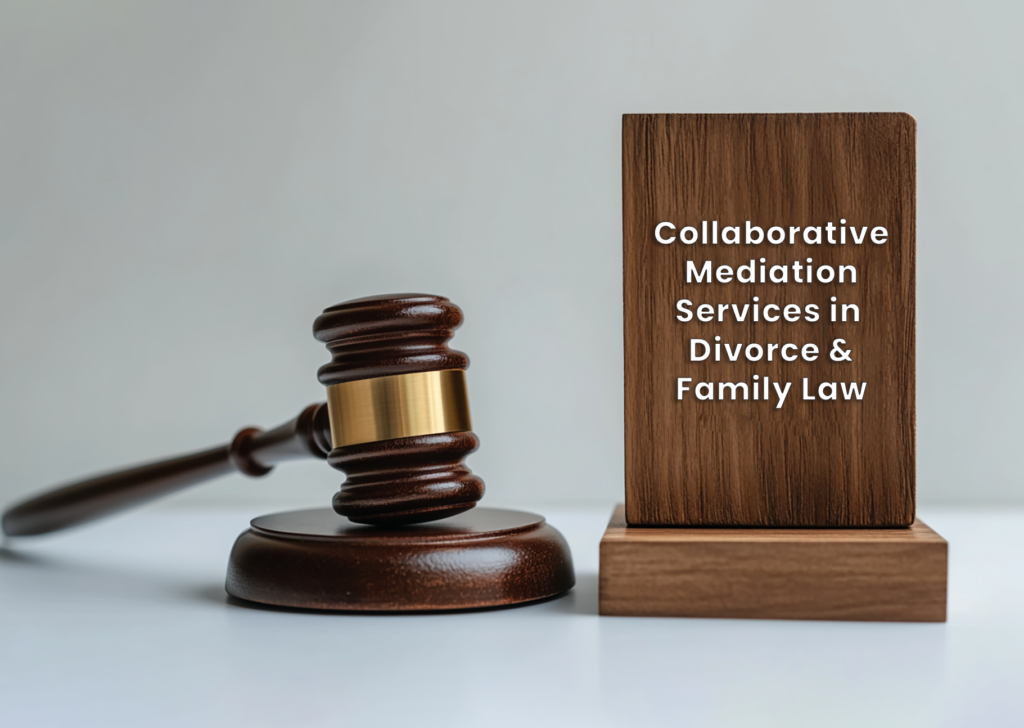
The Role of Collaborative Mediation Services in Divorce & Family Law
Collaborative mediation services play a crucial role in resolving family law disputes by promoting open communication and mutual agreement. Family law disputes, including divorce and separation, can be emotionally and financially draining. In Australia, alternative dispute resolution (ADR) methods like collaborative law and mediation provide a structured, cooperative approach to resolving issues without court intervention. These methods promote amicable agreements, ensuring fair outcomes while minimising stress and legal costs for all parties involved.
Table of Contents
Understanding Collaborative Mediation Services

Collaborative mediation services combine the principles of mediation and collaborative law to facilitate constructive discussions between separating couples. Unlike court battles, which are adversarial, collaborative mediation promotes cooperation, helping parties reach mutually beneficial agreements regarding parenting arrangements, financial settlements, and asset division. The process is facilitated by neutral family mediators and legally trained collaborative lawyers, ensuring a fair and structured negotiation.
Benefits of Mediation in Family Law
- Cost-effective – Mediation is significantly cheaper than prolonged court battles, with lower legal fees and reduced procedural costs.
- Time-efficient – Court proceedings can take months or even years, whereas mediation can resolve disputes within weeks.
- Confidentiality – Unlike court cases, mediation is private, ensuring sensitive family matters remain undisclosed.
- Preserves relationships – Encourages respectful communication, which is crucial for co-parenting and maintaining civil relations post-separation.
- Control over outcomes – Couples have the flexibility to tailor solutions rather than having a judge impose a ruling.
How Collaborative Law Works in Divorce Cases?
Collaborative law focuses on interest-based negotiation, where both parties and their lawyers work together to find solutions that best meet their needs. Key elements include:
- The collaborative process – Both spouses and their lawyers sign a participation agreement, committing to resolve disputes outside of court.
- Transparency & cooperation – Open and honest discussions about finances, parenting, and property division.
- Avoiding litigation – If collaboration fails, lawyers involved in the process must withdraw, ensuring all parties remain dedicated to reaching an agreement.
This approach is particularly effective in cases where both parties are willing to communicate openly and prioritise resolution over conflict.
Key Areas Addressed in Mediation & Collaborative Law
Mediation and collaborative law cover a wide range of family law matters, including:
- Parenting arrangements – Establishing custody, visitation schedules, and decision-making responsibilities for children.
- Property division – Negotiating the fair distribution of assets, debts, and shared property.
- Financial & child support – Determining appropriate child support and spousal maintenance based on financial circumstances.
These processes help couples make informed, fair, and legally sound agreements without court intervention.
Legal Requirements & ADR in Australia
Under the Family Law Act 1975, parties involved in family disputes are required to attempt ADR before filing for court proceedings, except in cases involving domestic violence or urgent matters. Key legal aspects include:
- Compulsory mediation – Parents must attend Family Dispute Resolution (FDR) before applying for parenting orders in court.
- Family Relationship Centres & accredited mediators – Government-supported services help facilitate mediation in a neutral environment.
- Binding & non-binding agreements – Mediation agreements can be formalised as legally enforceable Consent Orders or remain as informal agreements.
ADR aligns with the Australian government’s push for less adversarial and more cooperative family law resolutions.
Choosing the Right ADR Approach
Selecting between mediation and collaborative law depends on several factors:
- Mediation is ideal when both parties can communicate and negotiate but need a neutral third party to guide discussions.
- Collaborative law is better when legal expertise is needed to explore complex financial matters or draft legally binding agreements.
- Litigation may still be required if one party is unwilling to cooperate or if there are significant legal disputes.
Finding the right family mediator or collaborative lawyer ensures the best possible outcome for both parties, tailored to their specific needs.
Conclusion

Collaborative mediation services offer a practical, cost-effective, and less stressful alternative to traditional divorce litigation. By encouraging open communication and mutual agreement, these methods help families navigate separation with dignity and fairness. If you’re facing a family law dispute, exploring ADR options like mediation and collaborative law can lead to a smoother, more amicable resolution.
If you need help, feel free to Contact Us at any time at Noble & Noble Mediations. We have qualified mediators ready to help.
Call Us for 24/7 support – 0497 434 460
Find Qualified Brisbane Family Mediators at Noble & Noble Mediations on google maps.
You also like to learn more about:
FAQs on Collaborative Mediation Services
What is collaborative mediation?
Collaborative mediation is an alternative dispute resolution (ADR) process where separating couples work with a neutral mediator and their respective lawyers to resolve disputes without going to court. It encourages open communication, cooperation, and mutually agreed-upon solutions for issues like parenting arrangements, property division, and financial settlements. The process is voluntary, confidential, and non-adversarial, helping couples reach fair outcomes while reducing stress, costs, and time compared to traditional litigation.
What is the collaborative approach in family law?
The collaborative approach in family law focuses on resolving disputes through cooperation rather than court battles. It involves both parties and their lawyers signing a written agreement to negotiate in good faith and find solutions that benefit everyone involved, especially children. This approach prioritises interest-based negotiation, allowing couples to explore creative solutions while maintaining respectful communication, making it an effective and less confrontational alternative to litigation.
What is an example of a collaborative approach?
An example of a collaborative approach in family law is when divorcing parents work together with their lawyers and a family mediator to create a parenting plan. Instead of a judge deciding custody arrangements, the parents openly discuss and agree on schedules, responsibilities, and co-parenting strategies. This method ensures a child-focused resolution, reduces conflict, and fosters a more amicable relationship between the parents for the well-being of their children.
What is the difference between collaborative practice and mediation?
While both collaborative practice and mediation aim to resolve disputes outside of court, they differ in approach:
- Mediation involves a neutral third party (a mediator) facilitating discussions but does not provide legal advice.
- Collaborative practice includes both parties and their collaborative lawyers, who actively guide negotiations while committing to avoiding litigation.
- Collaborative practice is more structured and ensures legal support, while mediation is more flexible and often used for direct negotiations without lawyers.
Why is collaborative mediation beneficial for family law disputes?
Collaborative mediation offers several benefits, including cost savings, faster resolution, and reduced emotional stress. It keeps matters private compared to court proceedings, allowing for more personalised agreements tailored to the family’s unique needs. Additionally, it helps preserve relationships, particularly in cases involving co-parenting, by fostering open communication and cooperative decision-making rather than adversarial arguments in court.
When is collaborative mediation suitable?
Collaborative mediation is best suited for cases where both parties are willing to cooperate and discuss matters in good faith. It is particularly effective for parenting agreements, property settlements, financial disputes, and spousal maintenance. However, if there is a history of domestic violence, power imbalances, or unwillingness to compromise, court intervention may be necessary instead.
Can collaborative mediation be legally binding?
Yes, agreements reached through collaborative mediation can become legally binding. Once both parties agree on the terms, their lawyers can formalise the agreement into a Binding Financial Agreement (BFA) or apply for Consent Orders through the Family Court. This ensures that the agreements are legally enforceable while still being achieved through a cooperative process rather than litigation.
How long does the collaborative mediation process take?
The length of collaborative mediation depends on the complexity of the issues and how quickly both parties reach an agreement. Simple matters like parenting plans may be resolved in one or two sessions, while more complex cases, such as financial settlements, may take several weeks or months. However, it is significantly faster than traditional court proceedings, which can take over a year to finalise.
What happens if collaborative mediation fails?
If collaborative mediation fails and no agreement is reached, parties may need to proceed to litigation. In collaborative practice, the lawyers involved must withdraw, and the parties must hire new legal representatives if they choose to go to court. This requirement ensures that all parties are fully committed to the mediation process and genuinely working toward a resolution.
How can I find a qualified collaborative mediator in Australia?
You can find a qualified collaborative mediator in Australia through organisations like the Australian Mediation Association (AMA), Family Dispute Resolution (FDR) providers, or legal professionals trained in collaborative law. It’s important to choose a mediator with experience in family law and ADR processes to ensure a smooth and effective resolution tailored to your needs.




